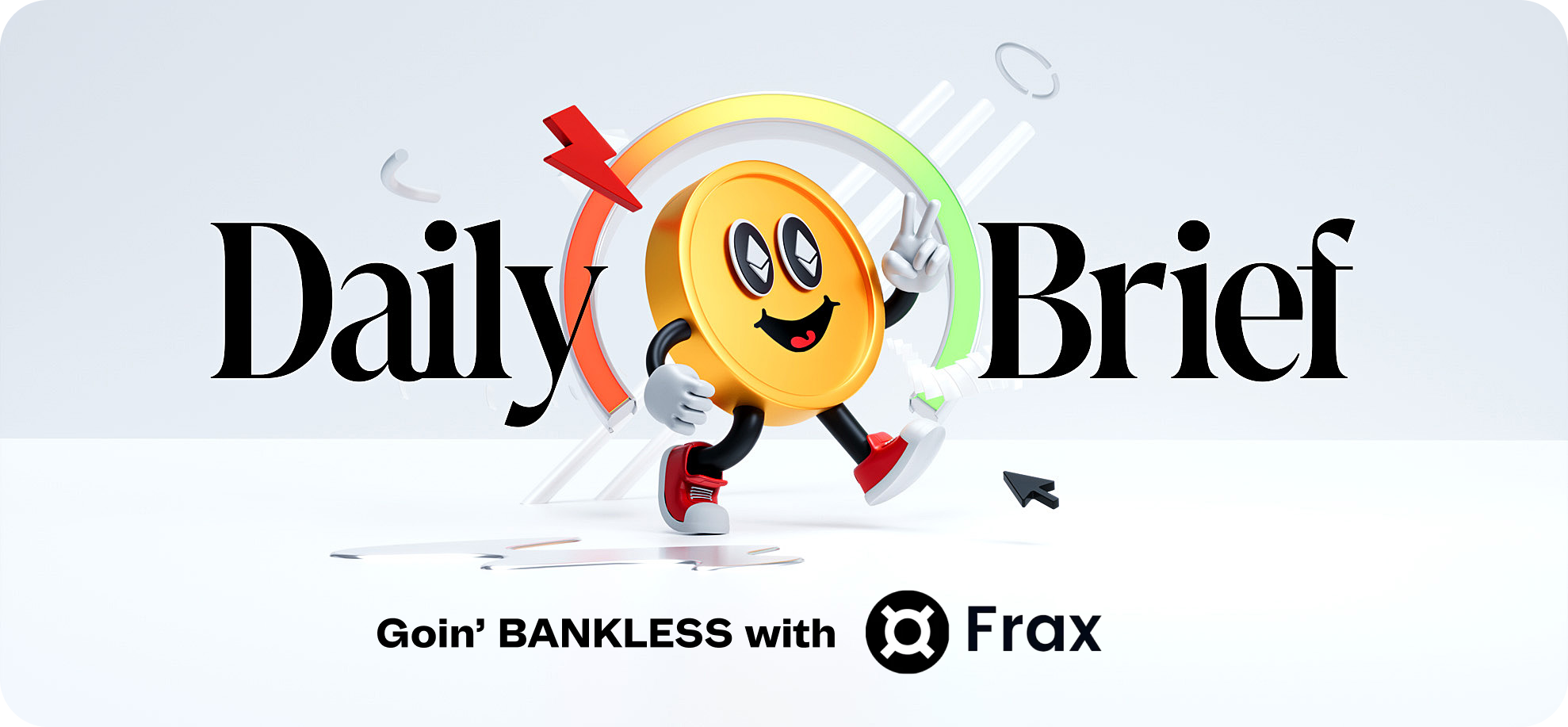
gm Bankless Nation,![]() Hyperliquid recently opened to permissionless onchain markets, so let's dig into the details.
Hyperliquid recently opened to permissionless onchain markets, so let's dig into the details.
Today's Issue ⬇️
- ☀️ Need to Know: Saylor Denies Dump Rumors
Strategy's Bitcoin buys "accelerating."
Bitcoin buys "accelerating." - 🔬 Analysis: Hyperliquid's New Onchain Markets
Inside the start of the HIP-3 era.
Sponsor: Frax — Fraxtal Ecosystem: Where DeFi Meets AI.

- 🚫 Michael Saylor Dismisses Strategy BTC Sale Rumors. The Strategy CEO reaffirmed that the firm is accumulating Bitcoin, with its purchases “accelerating."
- 💸 Public ETH Accumulator BTCS Logs Strongest Quarter Yet. BTCS’s
 Ethereum bet is paying off, with Q3 2025 revenue rising 78% quarter over quarter.
Ethereum bet is paying off, with Q3 2025 revenue rising 78% quarter over quarter. - 📈 New XRP ETF Surges as BTC and ETH Funds See $1B Exodus. Canary Capital's XRPC fund arrived to a trading frenzy as other major crypto ETFs dipped.
| Prices as of 5pm ET | 24hr | 7d |

|
Crypto $3.32T | ↘ 2.6% | ↘ 4.0% |

|
BTC $94,986 | ↘ 3.8% | ↘ 8.4% |

|
ETH $3,166 | ↘ 0.2% | ↘ 7.9% |

It’s been about a month since Hyperliquid Improvement Proposal 3, better known as HIP-3, went live.
A long-anticipated upgrade, HIP-3 equips the HyperCore (the exchange layer of Hyperliquid rather than the EVM layer, the HyperEVM) with the ability to support permissionless listings — meaning anyone, or rather anyone with 500K$ HYPE to stake, can deploy custom markets with the exchange’s liquidity.
This dynamic opens the platform up to the possibility of becoming the place to long or short everything: stocks (via Trade or Felix), commodities, bonds (via Aura), Pre-IPOs (via Ventuals), even Pokémon cards (via Trove) — essentially any asset under the sun.
The upgrade works like this: a deployer, someone who wants to launch a HIP-3 market, stakes 500K $HYPE (~$19.3M at time of writing). They can then list three markets for free before entering an auction process to secure additional slots.
For each market they launch, the deployer sets leverage limits, configures the oracle, and manages all the key technicalities of operating the market(s). To make sure this is done to an acceptable level, deployers run the risk of having their stake slashed, though Hyperliquid notes this mechanism is temporary and expected to fade as standards and tooling improve.
Once live, the deployer earns 50% of the fees from their markets, with Hyperliquid taking the other half. To balance revenue, HIP-3 market fees are set at double those of standard markets, keeping Hyperliquid’s take roughly equivalent.
While most deployers are still building, early activity from just one, single HIP-3 market already live — to the tune of $1.3B in volume — paints a positive picture that the upgrade’s potential may match its hype.
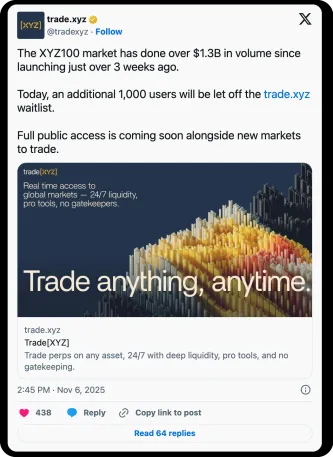
What Will the Impact of HIP-3 Be?
As a result of how it’s designed, HIP-3 introduces new supply crunches on $HYPE, additional revenue for buybacks, and even potentially increases the rewards earned by stakers and traders.
- Locking up $HYPE: Each deployer must stake 500K $HYPE, effectively removing that amount from circulation (albeit only if they can run a profitable endeavour). The result is persistent buying pressure as new deployers acquire $HYPE to secure their slots or maintain uptime. For example, Trove, an upcoming HIP-3 market for collectibles, raised $20M to purchase $HYPE for its launch. Further, and potentially more timely, Hyperliquid Digital Asset Treasuries (DATs) like Hyperion and Hyperliquid Strategies have already begun exploring how to get involved in HIP-3, alleviating the threat of these vehicles dumping their tokens as we’re seeing more and more DATs do.
- Additional revenue for buybacks: The 50/50 fee split on HIP-3 markets provides a new inflow to the protocol Assistance Fund, which uses 97% of all fees to buyback its token. Because HIP-3 market fees are set higher than standard ones, this stream will not be reduced by the split in fees with the deployer, potentially offering a significant source for $HYPE buybacks if even a handful of markets achieve sustained volume.
- Incentive Wars: A likely next phase is direct competition among deployers for trader flow, especially given the success of Trade’s XYZ100 HIP-3 market, which generated $100K in fees for the deployers before it even reached two weeks. Especially for stock-related markets, expect escalating incentive programs — liquidity mining, fee rebates, staking boosts — as providers fight to draw and retain users. These will likely not only be reserved for traders, but $HYPE stakers too as validators vie for stake to participate in secondary economics like “exchange-as-a-service” models, where staking providers like Kinetiq essentially crowdsource $HYPE to lower the cost of launching a market.
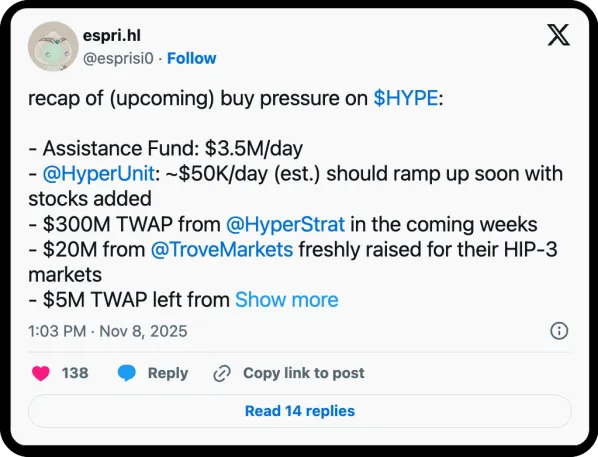
Together, these dynamics tighten HYPE’s supply, expand its buyback base, and create new competitive layers across the ecosystem. But while the incentives are clear, execution remains the variable — and that’s where HIP-3’s real test lies: whether these markets can launch successfully and generate lasting demand.
How Could HIP-3 Fail?
Nothing is set in stone though and, at the end of the day, HIP-3’s success will depend on two things: quality markets launching, and those markets generating sustained demand.
As one might expect, permissionless listings don’t guarantee quality. A HIP-3 market is only as strong as its deployer — how they configure leverage, oracles, and risk parameters. Deploying non-crypto or thinly traded assets like stocks or bonds requires continuous data and stable pricing. Without that, markets face thin liquidity, wide spreads, and erratic execution that will quickly drive traders away.
This is where specialized tools matter. Oracle providers like RedStone are building hybrid systems that blend onchain and offchain data, maintaining live pricing even when the base asset isn’t trading (for example, if the stock market is closed). HIP-3’s architecture comes prepared for this, allowing deployers to implement the proper oracles into individual markets and tailor risk parameters accordingly.
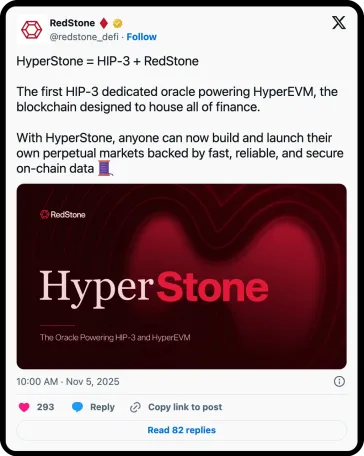
But, even then, demand remains the harder part. As Felix Protocol’s founder Charlie notes, the lion’s share of Hyperliquid’s volume comes from five markets, mostly composed of major assets like $BTC, $ETH, and $SOL. Thus, smaller assets tend to be left with little natural flow, meaning nascent, niche assets launched via HIP-3 will face a cold-start problem. Without early liquidity, traders hesitate; without traders, liquidity providers leave.
In other words, if simply introducing novel markets of stocks, bonds, what-have-you, isn’t enough to spark activity, deployers will need to experiment with market structures and pairs, introducing new collateral for perps or unique pair-markets like $BTC/$GOLD, for example. There are many ways to experiment here, and of course incentive programs should help smooth the initial launch. But, in the end, these markets will have to stand on their own.
Ultimately, HIP-3’s trajectory depends on the competence of its deployers. The framework is in place, but its outcome will hinge on whether deployers can build markets that trade well and sustain activity — markets that make HIP-3 function as a lively expansion of the Hyperliquid ecosystem rather than just a hanger-on.
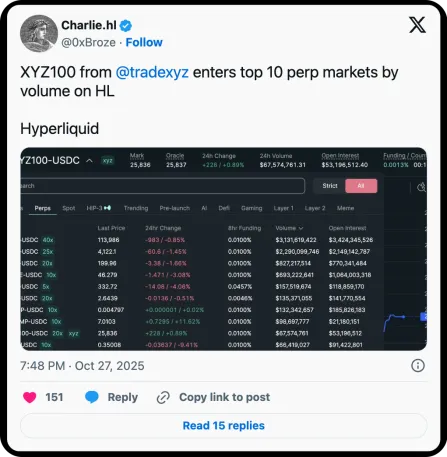
Final Thoughts
Overall, HIP-3 represents, and should be interpreted as, another structural bet on decentralization — a next step for Hyperliquid shifting responsibility for growth from the protocol to its participants, building on a growing validator count and a new “native” stablecoin.
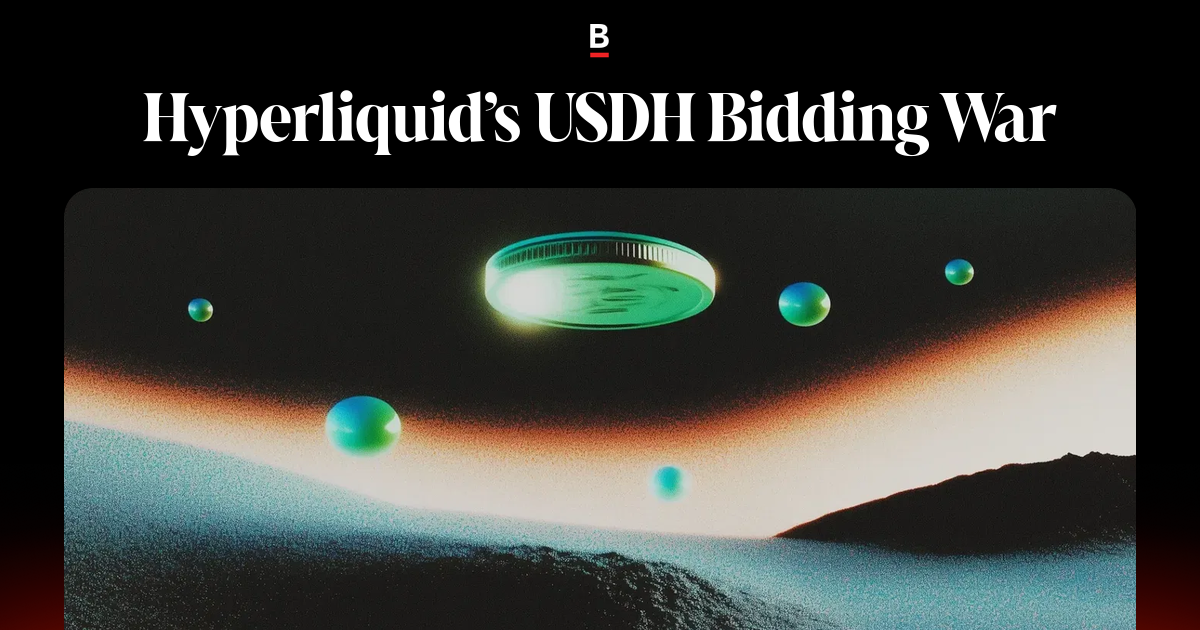
Whether it succeeds will come down to the quality of the markets that launch, the liquidity they attract, and the flywheel effects that follow. If deployers can navigate those early hurdles, HIP-3 could define the next phase of onchain market design.
It also doesn’t need scale in the traditional sense to succeed. As Charlie noted, just a few high-performing markets — even one or two — could validate the model and materially impact both Hyperliquid’s growth and $HYPE’s price, with one firm, FalconX, estimating $.8B in additional fees if HIP-3 is successful at capturing less than one percent of Mag7 derivatives trading.
While this is just some number, I share it to emphasize that capturing even a small share of legacy derivatives would bring Hyperliquid substantial growth.
For the platform that keeps defying expectations, rising from a fully-bootstrapped team in two years — equipped with zero VC funding — to become a protocol responsible for earning 35% of all blockchain revenue some months, the most profitable company by revenue per employee in the world, and one pandered to by Fortune 500 companies, the success of HIP-3 wouldn’t be something I bet against.

The Fraxtal ecosystem is expanding at lightning speed—this month’s biggest highlight is IQAI.com, the newest Agent Tokenization platform from IQ and Frax. IQ is building autonomous, intelligent, tokenized agents launching on Fraxtal in Q1. Empower onchain agents with built-in wallets, tokenized ownership, and decentralized governance—all within a fast-growing Fraxtal ecosystem.





